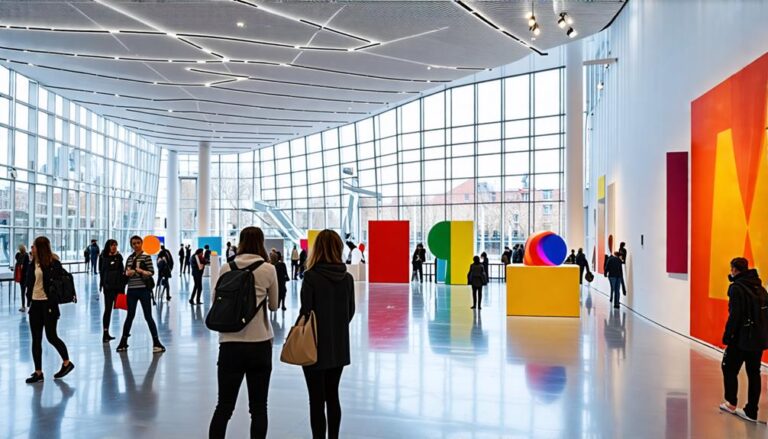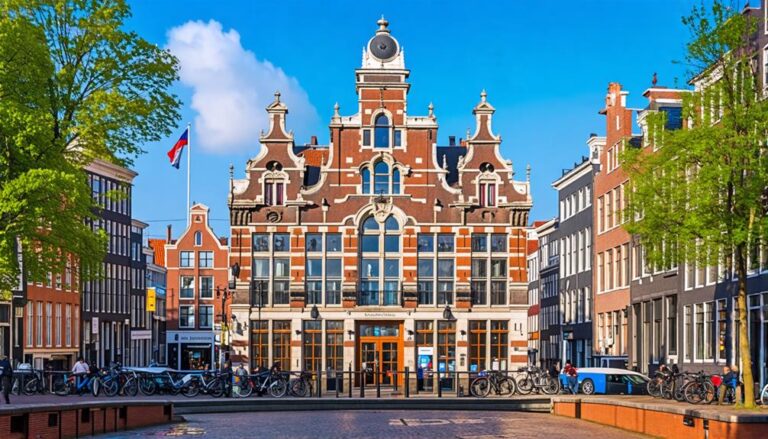Anne Frank House: A Historical Museum
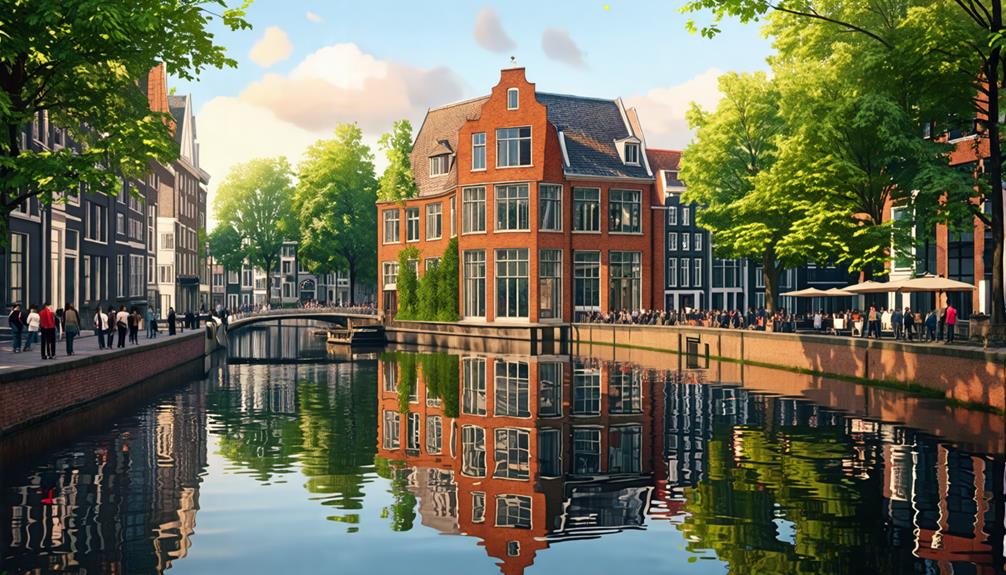
Situated in the heart of Amsterdam, the Anne Frank House stands as a poignant historical museum. It commemorates Anne Frank and her family's harrowing experiences during the Holocaust.
The famous Secret Annex is here, offering a tangible connection to the past with preserved artifacts like Anne's original diary. Opened in 1960, the museum attracts over 1.3 million visitors every year, underscoring its global importance.
You can engage with educational programs on the Holocaust and human rights. A visit typically lasts 1 to 2 hours. To truly appreciate this profound site and its lessons, continue exploring its unique offerings.
Key Takeaways
- The Anne Frank House in Amsterdam is a poignant museum dedicated to Anne Frank's life and the Holocaust.
- The preserved Secret Annex, where the Frank family hid, showcases original artifacts.
- Educational programs focus on the Holocaust and human rights.
- The museum draws over 1.3 million visitors annually, showcasing its global significance.
When planning vacations to the Netherlands, the Anne Frank House should be on your list of must-visit museums. The museum offers a unique, historical experience that connects visitors to the past in a meaningful way. You can see the very rooms where Anne Frank wrote her famous diary, which provides a personal glimpse into her life during a dark period in history.
The museum's educational programs are also a profound way to learn about the Holocaust and human rights. These programs are designed to educate and inspire, making your visit both informative and moving.
Make sure to book your tickets in advance. The museum is very popular, and tickets are limited each day. This ensures that your experience is not just memorable but also smooth and hassle-free. So, when planning your trip to Amsterdam, include the Anne Frank House for an enriching experience.
Museum Overview
Let's explore the Anne Frank House at Prinsengracht 263-267 in Amsterdam. This poignant museum is dedicated to the life and legacy of Anne Frank. The museum offers a deeply moving experience.
Walking through the preserved Secret Annex, where Anne Frank, her family, and others hid during the Jewish wartime, gives a tangible connection to their struggle for freedom.
The Anne Frank House showcases original items from that period. You can see Anne's famous diary and the kitchen furnishings that were part of their daily life. These artifacts remind us of their resilience and the harsh realities they faced.
Since opening as a museum on May 3, 1960, the Anne Frank House has become one of the most visited sites in the Netherlands. In 2017, it drew 1.27 million visitors.
An audio tour is available, including versions for children, and audiovisual guides help us understand the exhibits and the historical context. Limited photography is allowed, so it's best to check the official website for specific rules.
The Anne Frank House in Amsterdam is a must-visit for anyone interested in history and human rights. It offers a unique and emotional journey into the past.
Historical Context
The Anne Frank House is a poignant destination for anyone vacationing in the Netherlands and interested in museums. Situated in Amsterdam, this historic site offers a vivid look into the grim realities of World War II and the Holocaust. As you walk through its rooms, you feel the weight of Jewish wartime experiences that affected Anne Frank's life.
Otto Frank, Anne's father, moved his office to Prinsengracht 263-267 on December 1, 1940. This building later became a hidden refuge called the Secret Annex. Here, the Frank family hid for over two years before their tragic arrest in 1944.
During World War II, the persecution of Jews reached horrifying levels. About 70% of the Dutch Jewish population perished in the Holocaust. Anne Frank's diary, first published in Dutch in 1947, tells the touching story of her family's fight for survival. Her words still touch hearts, reminding us of the harsh realities faced by millions.
The Anne Frank House became a museum on May 3, 1960. It honors Anne's legacy and educates visitors about this dark period. It's more than just a building; it's a symbol of resilience and a reminder of the past to ensure a freer future. Through its exhibits, you gain a deeper understanding of the massive impact of World War II on Jewish lives.
The Secret Annex
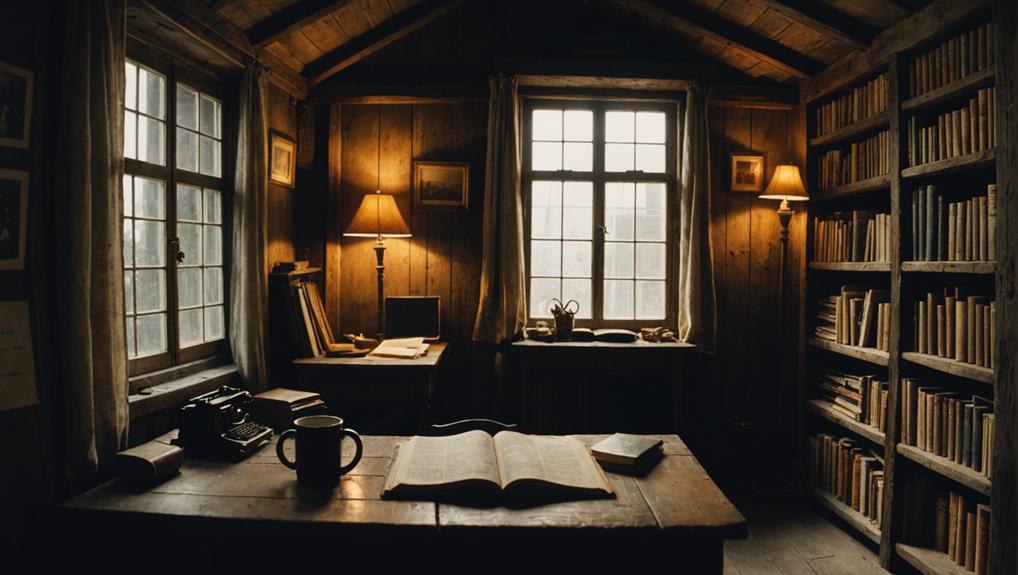
The Secret Annex is a hidden refuge that sheltered Anne Frank, her family, and the van Pels family for over two harrowing years during World War II. This concealed space, accessed through a door behind a bookshelf, housed several rooms that served as their living quarters and workspace. Walking through the annex, you'll see preserved furnishings and Anne's original diary pages. It offers a poignant, emotional experience, connecting you directly to their daily struggles and resilience.
Visiting the Anne Frank House in Amsterdam is a must for anyone interested in history. It provides a unique glimpse into the life of a young girl who became a symbol of hope and human spirit. The museum is meticulously maintained, allowing visitors to step back in time and truly understand the gravity of the situation faced by Jewish families during the Nazi occupation.
The Secret Annex is part of the Anne Frank House museum, which also includes exhibitions on discrimination and persecution. It's a powerful reminder of the past and serves as an educational platform for promoting tolerance and human rights.
For those planning a vacation to the Netherlands, the Anne Frank House is an essential stop. It not only enriches your understanding of history but also offers a deeply moving experience that stays with you long after you leave. Exploring this museum gives you a profound appreciation for the resilience of the human spirit and the importance of remembering our past.
Historical Hideout Details
Nestled behind the Anne Frank House, the Secret Annex served as a hidden refuge for Anne Frank and her family for over two years during World War II. Known in Dutch as the Anne Frank Huis, this hiding place consisted of small, cramped rooms that highlighted the constant danger and challenges faced by those in hiding.
The annex remains a powerful symbol of their resilience, with original belongings like furniture and personal items preserved to provide a tangible connection to their lives during this harrowing period.
Visitors can step into the actual room where Anne wrote her diary, a significant historical document that offers personal insights into her experiences and thoughts during the Holocaust. Her diary was published after her death, illuminating the human cost of war and the enduring spirit of those who lived through it.
The museum has meticulously recreated the atmosphere of the 1940s within the Secret Annex. This enhances the emotional impact of the visit and offers a deep, immersive understanding of life in hiding.
Through these preserved spaces and personal artifacts, we gain a profound appreciation of the fight for freedom and the indomitable human spirit that Anne Frank and her family exemplified.
Emotional Visitor Experience
Stepping into the Secret Annex, visitors feel the weight of history and the profound impact of Anne Frank's story. This tiny, confined space, where Anne and her family hid for over two years, emphasizes the trauma and fear experienced during the Holocaust. Walking through the annex, many find a lump in their throats, connecting deeply with Anne's story through her authentic diary entries and personal belongings preserved in the museum.
The museum's atmosphere, meticulously recreated to reflect the 1940s, immerses visitors in the historical context of Anne's life. This thoughtful recreation enhances the emotional resonance of the experience. Photography is limited inside the Secret Annex to maintain a somber and reflective environment. This respectful silence amplifies the profound impact of the space.
Typically, a visit lasts 1 to 2 hours, allowing ample time for contemplation and emotional reflection. The museum's 4.5-star rating underscores visitor satisfaction, highlighting the depth of the experience. Upon leaving, visitors carry with them a deeper understanding of Anne Frank's resilience and the enduring impact of her story, reflecting on the freedoms often taken for granted.
Visitor Experience
A visit to the Anne Frank House usually lasts between 1 to 2 hours, leaving a profound emotional impact on most visitors. The museum's small, confined spaces vividly illustrate the trauma Anne Frank and her family endured while hiding during the Holocaust. Authentic diary entries and artifacts bring us closer to Anne Frank's story, creating a deep emotional resonance as we explore each room.
The museum offers audio tours, including child-friendly versions, to help us understand the historical context of the exhibits. Audiovisual guides provide detailed explanations of each room's layout and significance, making our visit informative.
Limited photography is allowed. Familiarize yourself with the specific rules before your visit. The respectful silence maintained throughout the museum underscores the solemnity of the experience, allowing us to reflect deeply on the exhibits.
Here are four tips to enhance your visit:
- Arrive early to avoid the busiest times.
- Use the audio tour for detailed insights.
- Respect the photography rules to preserve the atmosphere.
- Take your time to fully absorb the exhibits.
This profound experience is more than a visit; it's a journey through history.
Booking and Tickets
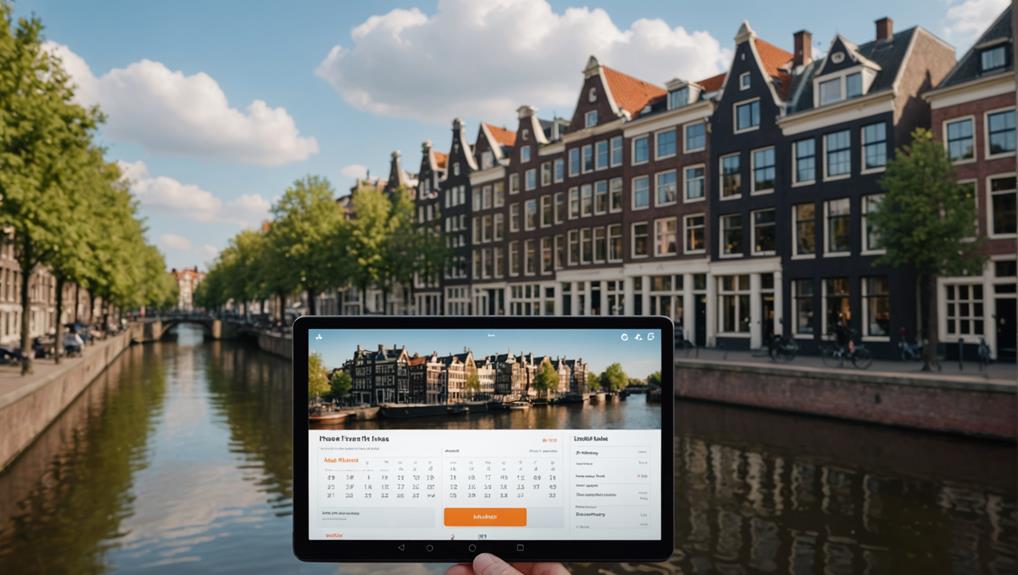
To ensure a well-organized visit to the Anne Frank House, understanding the booking and ticketing process is key.
Booking tickets in advance is crucial due to high demand. Reservations open six weeks ahead. We recommend planning our visit 4 to 6 weeks in advance to secure a spot, as tickets sell out fast. Each ticket grants us a timed entry slot, which ensures a steady flow of visitors and a better experience for everyone.
Same-day tickets become available daily at 9 AM, but these also go quickly. Early booking is important. Register on the official website before purchasing tickets. Once we complete our booking, a confirmation email will detail our visit's specifics. There's no waitlist for tickets, so timely planning is essential.
Punctuality is crucial. Late arrivals may not be accommodated, and missing our slot could mean forfeiting the visit.
Location and Accessibility
Vacations to Netherlands Attractions: Anne Frank House
The Anne Frank House stands at Prinsengracht 263-267 in Amsterdam. It's in the lively City Centre, close to the Royal Palace and Dam Square. The tram from Centraal Station offers a direct and scenic route to the museum.
Despite the historic building's steep and narrow staircases, the museum ensures accessibility for all visitors. Sensible footwear is recommended due to the structure's design. Museum staff are always ready to help enhance your visit.
Here are some tips to make the most of your visit:
- Use the Tram Network: The tram from Centraal Station provides a convenient and scenic route to the museum.
- Plan for Mobility: Be prepared for the steep staircases and wear comfortable shoes.
- Accessibility Options: The museum offers staff assistance and facilities for visitors with disabilities.
- Utilize Services: The museum has a free cloakroom for storing bags and jackets. Restrooms and seating areas are also available.
This unique museum offers a look into the life of Anne Frank and serves as a poignant reminder of the past. Your visit will be both educational and memorable.
Educational Value
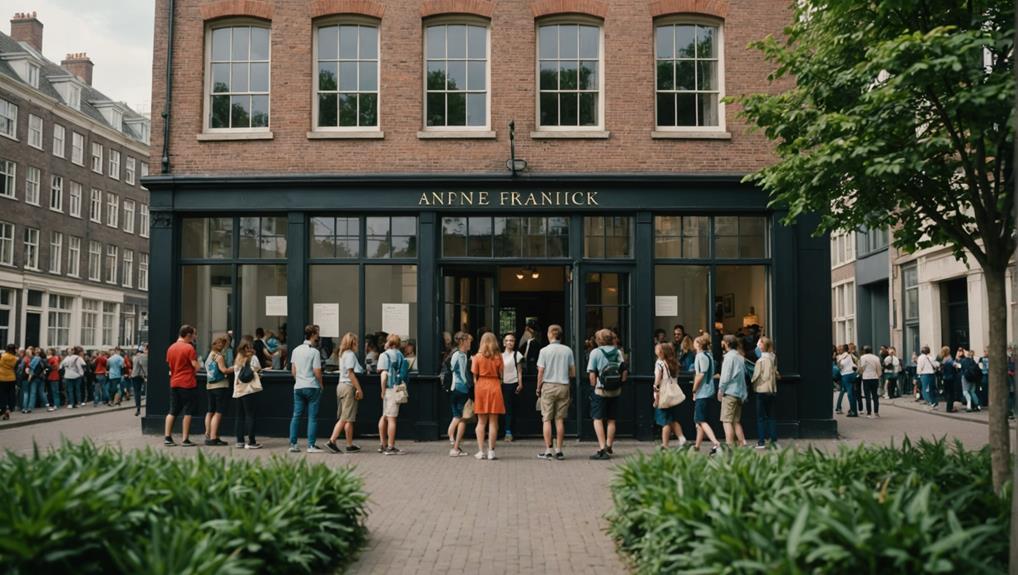
The Anne Frank House in Amsterdam offers profound educational value. By presenting Holocaust personal narratives, it humanizes historical events. Visitors gain insights into the lives affected by this atrocity. Through exhibits and Anne's diary, we understand the historical context and the dire consequences of intolerance. The museum focuses on lessons of tolerance and acceptance. It encourages us to reflect on our own attitudes and behaviors toward others.
When planning vacations to the Netherlands, consider including the Anne Frank House in your itinerary. This museum stands as a poignant reminder of the past. It provides an enriching experience for all ages. Exploring it helps us appreciate the importance of empathy and historical awareness.
Holocaust Personal Narratives
Anne Frank's House in Amsterdam is a must-visit for anyone traveling to the Netherlands. This unique museum educates visitors about the Holocaust through Anne Frank's vivid recounting of life in hiding. Her 'Diary of a Young Girl' offers an intimate glimpse into the Jewish wartime experience, providing a firsthand account of the fears and hopes endured by those in hiding. Her detailed writings humanize the abstract horrors of the Holocaust, making the historical events more accessible and relatable.
The educational value of her narrative is immense. It teaches us about the resilience of the human spirit in the face of great adversity. Visitors are moved by Anne's words and prompted to reflect on themes of tolerance, discrimination, and human rights. This reflection is essential in fostering a world that values freedom and empathy.
At the Anne Frank House, visitors can explore her story through exhibits that highlight:
- Her original diary and personal belongings
- Multimedia displays about her life
- Historical artifacts from the Holocaust
- Interactive installations promoting discussions on human rights
Visiting the Anne Frank House offers a profound experience that combines history, education, and reflection. It's a place where the past meets the present, urging us to build a better future.
Historical Context Insights
Understanding the historical context of Anne Frank's life enhances the educational value of her diary and the museum dedicated to her legacy. As a wartime diarist, Anne Frank's experiences give us a deeply personal view into the Jewish experience during the Holocaust. With the museum dedicated to Jewish history, we can better appreciate the gravity of the events that unfolded.
Visiting the Anne Frank House in Amsterdam is a significant part of experiencing the Netherlands' rich history. The house, where Anne and her family hid, stands as a poignant symbol of Jewish perseverance and suffering during World War II. Her diary, which documented daily life in hiding, offers a personal narrative of the Holocaust. The museum's exhibits, filled with artifacts and educational materials, promote historical understanding and reflection.
Anne's diary has been translated into over 70 languages, highlighting its global impact as an educational tool. The Holocaust, which led to the death of 70% of Dutch Jews, underscores the widespread tragedy of the era. By visiting the Anne Frank House, we can connect with this poignant history and gain a deeper appreciation for the resilience of those who lived through it.
Tolerance and Acceptance Lessons
Visiting the Anne Frank House during a vacation to the Netherlands offers invaluable lessons about tolerance and acceptance through powerful exhibits and the personal story of Anne's life. As you explore the museum, you gain a deeper understanding of the Holocaust's devastating impact. Seventy percent of the 150,000 Jews in the Netherlands perished. This stark reality highlights the critical need for tolerance and acceptance today.
Anne Frank's diary provides a poignant, personal perspective on war, fear, and hope. It fosters empathy, helping you understand the human emotions behind historical events. The museum stands as a memorial to WWII victims, sparking discussions on human rights and the dire consequences of discrimination and intolerance.
Educational exhibits detail Anne's life and the historical context of the Holocaust. They emphasize the importance of compassion and respect for diversity. The emotional impact of visiting the Secret Annex, where Anne and her family hid, prompts reflection on the significance of tolerance, acceptance, and the importance of standing against oppression.
Here are four ways to enhance your visit:
- Read Anne Frank's Diary: Gain a deeper personal connection.
- Explore the Secret Annex: Experience the somber reality of hiding.
- Engage with Exhibits: Investigate detailed historical contexts.
- Reflect on Human Rights: Discuss the ongoing need for tolerance and acceptance.
Tours and Activities
Exploring the Anne Frank House isn't just about the exhibits. The variety of tours and activities offered make the experience engaging and educational.
When planning your visit, consider the guided walking tours available. These tours explore Amsterdam's Jewish Quarter, providing historical context and connections to Anne Frank's story. To ensure you don't miss out, book in advance. Timed slots sell out quickly, especially during peak seasons.
For those visiting with children, the Anne Frank House offers an audio tour that includes child-friendly versions. This thoughtful addition helps younger visitors grasp the significance of what they're seeing.
Beyond the museum, other activities like canal cruises with live guides and food tours in the nearby Jordaan District complement the visit perfectly. These add-ons enrich our understanding of Amsterdam's rich history and culture.
Combining a trip to the Anne Frank House with other historical sites in Amsterdam creates a thorough and immersive experience. By integrating these varied activities into your itinerary, you can ensure a more meaningful and memorable exploration of Anne Frank's legacy and the broader historical landscape of Amsterdam.
Frequently Asked Questions
Is the Anne Frank House the Same as the Museum?
No, they're not the same. The Anne Frank House refers to the actual building where Anne Frank and her family hid during World War II. The museum represents the organized effort to educate visitors about Anne Frank's life, the historical context of her story, and related exhibits. It enhances the visitor experience by providing detailed information and emotional insights.
If you're planning a vacation to the Netherlands, visiting the Anne Frank House in Amsterdam is a must. The house itself offers a unique, historical ambiance. The museum provides depth, offering artifacts, photos, and videos. Both elements together provide a comprehensive understanding of this poignant piece of history.
What Is the Historical Significance of the Anne Frank House in Amsterdam?
The Anne Frank House in Amsterdam is a must-see for anyone visiting the Netherlands. It's a deeply moving cultural memorial that offers profound insights into World War II and the Holocaust. This museum honors Jewish heritage and the tragic story of Anne Frank.
Located on the Prinsengracht canal, the Anne Frank House is where Anne Frank and her family hid from the Nazis for over two years. Today, it stands as a powerful reminder of the resilience of the human spirit in the face of unimaginable adversity.
Inside, visitors can explore the Secret Annex where Anne wrote her famous diary. The rooms have been preserved to reflect the conditions the Frank family endured. This immersive experience allows you to step back in time and gain a deeper understanding of their plight.
The museum also features an extensive collection of historical documents, photographs, and personal artifacts. These items provide context and enrich the narrative of Anne Frank's life.
The Anne Frank House isn't just a historical site; it's a place of education and reflection. It serves as a stark reminder of the consequences of hatred and intolerance. Visiting this museum is a sobering yet essential part of any trip to Amsterdam.
Is Anne Frank's Diary in a Museum?
Anne Frank's diary is housed in the Anne Frank House in Amsterdam. This museum offers a profound experience. Visitors can explore the secret annex where Anne and her family hid during World War II. The museum provides deep insights into Anne's life and the historical context of her writings. Her diary remains a symbol of hope and resilience.
A visit to the Anne Frank House is a moving journey through history. The museum's exhibits are thoughtfully curated. They shed light on the impact of Anne's words and the legacy she left behind. Walking through the rooms where Anne wrote her diary entries, visitors feel a connection to her story.
Amsterdam has many other captivating museums. The Rijksmuseum houses masterpieces by Rembrandt and Vermeer. The Van Gogh Museum displays the largest collection of Van Gogh's paintings. Each museum offers unique perspectives on art, history, and culture.
Exploring these museums can make a vacation to the Netherlands unforgettable. They provide enriching experiences that blend education with inspiration.
Can You Visit the Real Anne Frank House?
Yes, you can visit the real Anne Frank House. The house, located in Amsterdam, offers a poignant glimpse into Anne Frank's life during World War II. Touring the hidden rooms where Anne and her family lived in hiding, visitors gain a deeper understanding of wartime hardships and the resilience of the human spirit. The museum preserves personal artifacts and diary entries, making it a powerful reminder of history's impact. It's an essential stop for anyone exploring the cultural and historical attractions of the Netherlands.
Conclusion
The Anne Frank House offers a powerful glimpse into history. Over 1.3 million visitors come each year. This museum preserves the Secret Annex and educates us on the harrowing experiences of Anne Frank and her family. Walking through these rooms gives a profound understanding of the courage and resilience required during such dark times.
The museum is located in Amsterdam, a city renowned for its rich culture and history. It stands as a tribute to Anne's enduring spirit and the horrors of World War II. It's an essential stop for anyone interested in history.
When planning a vacation to the Netherlands, consider adding this unique museum to your itinerary. You'll foster a deeper connection to our past.





